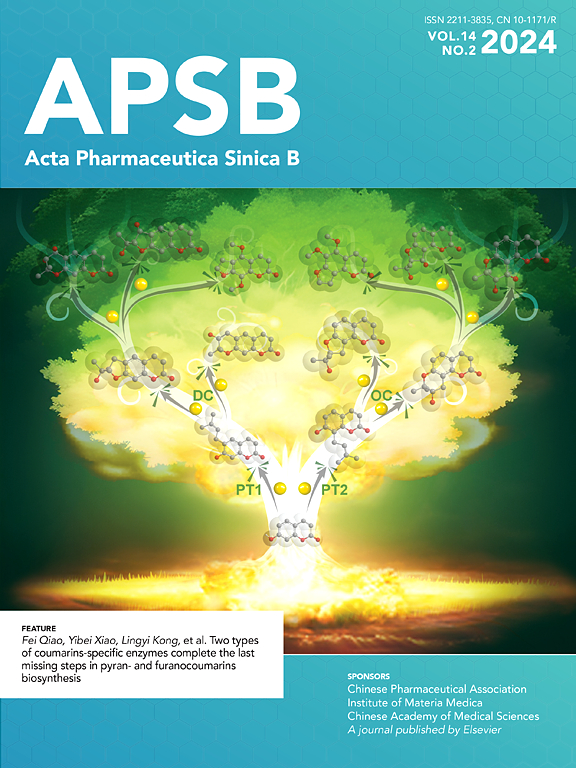A critical role for Phocaeicola vulgatus in negatively impacting metformin response in diabetes
IF 14.6
1区 医学
Q1 PHARMACOLOGY & PHARMACY
引用次数: 0
Abstract
Metformin has been demonstrated to attenuate hyperglycaemia by modulating the gut microbiota. However, the mechanisms through which the microbiome mediates metformin monotherapy failure (MMF) are unclear. Herein, in a prospective clinical cohort study of newly diagnosed type 2 diabetes mellitus (T2DM) patients treated with metformin monotherapy, metagenomic sequencing of faecal samples revealed that Phocaeicola vulgatus abundance was approximately 12 times higher in nonresponders than in responders. P. vulgatus rapidly hydrolysed taurine-conjugated bile acids, leading to ceramide accumulation and reversing the improvements in glucose intolerance conferred by metformin in high-fat diet-fed mice. Interestingly, C22:0 ceramide bound to mitochondrial fission factor to induce mitochondrial fragmentation and impair hepatic oxidative phosphorylation in P. vulgatus-colonized hyperglycaemic mice, which could be exacerbated by metformin. This work suggests that metformin may be unsuitable for P. vulgatus-rich T2DM patients and that clinicians should be aware of metformin toxicity to mitochondria. Suppressing P. vulgatus growth with cefaclor or improving mitochondrial function using adenosylcobalamin may represent simple, safe, effective therapeutic strategies for addressing MMF.

普通Phocaeicola vulgatus对糖尿病患者二甲双胍反应的负面影响
二甲双胍已被证明可以通过调节肠道微生物群来减轻高血糖。然而,微生物组介导二甲双胍单药治疗失败(MMF)的机制尚不清楚。在一项对新诊断的2型糖尿病(T2DM)患者进行二甲双胍单药治疗的前瞻性临床队列研究中,粪便样本的宏基因组测序显示,无应答者的Phocaeicola vulgatus丰度约为应答者的12倍。P. vulgatus迅速水解牛磺酸偶联胆汁酸,导致神经酰胺积累,逆转了高脂肪饮食小鼠二甲双胍对葡萄糖耐受不良的改善。有趣的是,C22:0神经酰胺与线粒体裂变因子结合,诱导线粒体断裂,损害P. vulgatus定殖的高血糖小鼠的肝脏氧化磷酸化,二甲双胍可能加剧这一过程。这项工作表明二甲双胍可能不适合富含寻常假单胞菌的T2DM患者,临床医生应该意识到二甲双胍对线粒体的毒性。用头孢克洛抑制寻常假单胞菌生长或使用腺苷钴胺素改善线粒体功能可能是治疗MMF的简单、安全、有效的治疗策略。
本文章由计算机程序翻译,如有差异,请以英文原文为准。
求助全文
约1分钟内获得全文
求助全文
来源期刊

Acta Pharmaceutica Sinica. B
Pharmacology, Toxicology and Pharmaceutics-General Pharmacology, Toxicology and Pharmaceutics
CiteScore
22.40
自引率
5.50%
发文量
1051
审稿时长
19 weeks
期刊介绍:
The Journal of the Institute of Materia Medica, Chinese Academy of Medical Sciences, and the Chinese Pharmaceutical Association oversees the peer review process for Acta Pharmaceutica Sinica. B (APSB).
Published monthly in English, APSB is dedicated to disseminating significant original research articles, rapid communications, and high-quality reviews that highlight recent advances across various pharmaceutical sciences domains. These encompass pharmacology, pharmaceutics, medicinal chemistry, natural products, pharmacognosy, pharmaceutical analysis, and pharmacokinetics.
A part of the Acta Pharmaceutica Sinica series, established in 1953 and indexed in prominent databases like Chemical Abstracts, Index Medicus, SciFinder Scholar, Biological Abstracts, International Pharmaceutical Abstracts, Cambridge Scientific Abstracts, and Current Bibliography on Science and Technology, APSB is sponsored by the Institute of Materia Medica, Chinese Academy of Medical Sciences, and the Chinese Pharmaceutical Association. Its production and hosting are facilitated by Elsevier B.V. This collaborative effort ensures APSB's commitment to delivering valuable contributions to the pharmaceutical sciences community.
 求助内容:
求助内容: 应助结果提醒方式:
应助结果提醒方式:


